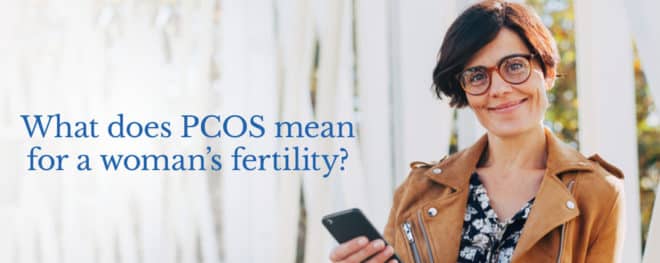
 by Dr Helen Peric, a fertility specialist at City Fertility Sydney CBD
by Dr Helen Peric, a fertility specialist at City Fertility Sydney CBD
Polycystic ovarian syndrome, also known as PCOS, affects approximately 12–21% of women of reproductive age1 globally. However, as the severity of symptoms experienced can vary drastically from person to person, it is estimated that a worrying 70% of women with PCOS remain undiagnosed1. With the ability to affect women’s mental health, self-esteem, fertility and general health, achieving an early diagnosis and medical management is critical to protecting the health and wellbeing of women diagnosed.
As a little understood women’s health issue, fertility specialist Dr Helen Peric, answers frequently asked questions about the impact of PCOS on the health of young women, how the condition can be managed and what it means for women wanting to start a family in future.
What is polycystic ovarian syndrome?
PCOS is a disorder in which hormones that govern the reproductive system are out of balance, with many symptoms due to high androgen levels and insulin resistance. Causes of the syndrome is still subject to debate, but it may be hereditary2.
Many with PCOS will have increased number of follicles recruited in their cycle but due to abnormal hormone input will not develop a dominant follicle, and hence ovulation will not occur. If you are not ovulating, you will not have a period or will have irregular periods. The reason women with PCOS may have issues with their fertility is due their irregular cycles.
What symptoms should women look out for?
Generally, for a woman to be diagnosed with PCOS, she must experience two out of the following three symptoms1:
- Irregular menstrual cycles (or complete absence of periods)
- Excessive testosterone production presenting as hormonal acne, increased body or facial hair and/or hair loss on the scalp
- Polycystic ovaries observed via ultrasound
PCOS is also frequently associated with significant weight gain, increased risk of insulin resistance and diabetes, heart disease, sleep apnoea and mental health issues such as anxiety and depression4.
Why are so many women still undiagnosed?
While symptoms often begin in early adolescence, the syndrome can be difficult to diagnose at this time as acne, weight gain and irregular periods can be common during this stage of development3. Additionally, many young women in their late teens may be prescribed hormonal contraception to treat a wide variety of issues, which can be used as a treatment for PCOS and often reduces or masks the symptoms experienced1. As a result, some women with a milder expression of PCOS might not achieve a diagnosis until later in life when trying to fall pregnant.
Additionally, as with many health conditions, the severity of symptoms can vary. Some women may find the condition has a major impact on their endocrine and metabolic health, while others may only present with irregular cycles and polycystic ovaries and feel otherwise healthy.
Should women experience any symptoms associated with PCOS, including an irregular cycle, it is best to consult a qualified healthcare professional. In addition to assessing signs and symptoms of PCOS, medical professionals will perform a physical exam, check blood hormone levels and perform an ovarian ultrasound to make a diagnosis.
How can the condition be treated?
First and foremost, the recommended treatment for managing symptoms of PCOS is a healthy lifestyle plan1. Women with PCOS often experience significant weight gain and may struggle to keep this under control2. However, symptoms experienced, and complications of the condition often worsen with an increased BMI, so it is crucial that women receive guidance around healthy eating and exercise1. PCOS is a condition that women diagnosed will need to manage throughout their entire lives, so developing healthy habits early is key to preventing the development of complications such as anxiety and depression, diabetes and heart disease.
Besides a healthy lifestyle some symptoms such as skin concerns may need other treatment. These include the use of an oral contraceptive to help decrease male hormone in circulation. If the OCP isn’t sufficient other medications to treat skin issues (spironolactone) can be started as well as topical cream to help control facial hair growth (eflornithine).
What does PCOS mean for a woman’s fertility?
A PCOS diagnosis is often associated with infertility, as irregular periods reduce the likelihood for natural conception to occur. When trying to fall pregnant, medication is available to help women ovulate (metformin)1. This is often quite effective in women with PCOS, as it helps return ovulation to its normal rhythm, allowing for natural conception. Ovulation Induction with Clomid was usually first line treatment but recently Letrozole has become first line treatment for PCOS to achieve ovulation.
In some cases, keyhole surgery may be recommended5. However, this is usually not undertaken without first exploring all other options.
It’s important to remember that a PCOS diagnosis does not mean natural conception is impossible, but those who have irregular cycles should be prepared for requiring assistance to achieve a pregnancy.
To find out more about polycystic ovarian syndrome and how it can affect your plans to conceive, visit https://www.cityfertility.com.au/pcos-key-things-to-know/ or consult with one od our fertility specialists.
References
- Boyle, J., & Teede, H., J. (2012). Polycystic ovary syndrome: An update. Australian Family Physician, 41 (10), 752-756. https://www.racgp.org.au/afp/2012/october/polycystic-ovary-syndrome/
- Sirmans, S. M., & Pate, K. A. (2013). Epidemiology, diagnosis, and management of polycystic ovary syndrome. Clinical epidemiology, 6, 1–13. doi:10.2147/CLEP.S37559
- Bani Mohammad, M., & Majdi Seghinsara, A. (2017). Polycystic Ovary Syndrome (PCOS), Diagnostic Criteria, and AMH. Asian Pacific journal of cancer prevention : APJCP, 18(1), 17–21. doi:10.22034/APJCP.2017.18.1.17
- Chaudhari, A. P., Mazumdar, K., & Mehta, P. D. (2018). Anxiety, Depression, and Quality of Life in Women with Polycystic Ovarian Syndrome. Indian journal of psychological medicine, 40(3), 239–246. doi:10.4103/IJPSYM.IJPSYM_561_17
- Mitra, S., Nayak, P. K., & Agrawal, S. (2015). Laparoscopic ovarian drilling: An alternative but not the ultimate in the management of polycystic ovary syndrome. Journal of natural science, biology, and medicine, 6(1), 40–48. doi:10.4103/0976-9668.149076







